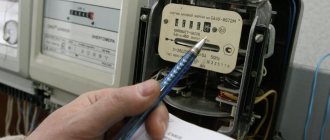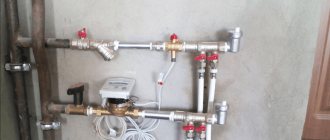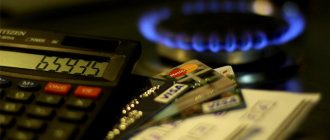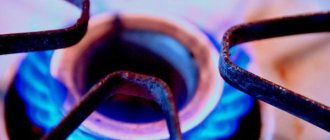Author of the article
Yulia Kuprina
Certified lawyer. Total work experience in the specialty is 13 years.
You can pay for thermal energy in different ways. The size of the fee depends not only on the number of batteries and the area of the apartment, but also on whether the apartment has heat meters. Let's figure out whether an individual heat meter is needed in an apartment building, where it is installed and how to take heat meter readings.
What to consider when deciding to install a meter
Depending on your heating system wiring, some difficulties may arise. So, with a horizontal wiring diagram, it will be enough for you to install one meter at the entrance of the heating pipes to the apartment, but what if you have a vertical wiring diagram. In my apartment I have a vertical layout and 4 risers of heating pipes, and it turns out that when installing a heat meter, I will have to install a meter for each heating device. Naturally, this option is not profitable, but not everything is so bad. Manufacturers of heat meters produce distributors that measure coolant flow based on the difference between the surface temperature of the heating device and the internal air temperature. The cost of this equipment along with installation will be approximately from 3 to 7 thousand rubles, it all depends on the configuration of the equipment.
Why is this necessary?
Apartment buildings
Everything is very simple: gigacalories are used in calculations for heat. Knowing how much thermal energy is left in the building, it is possible to issue a fully specific bill to the consumer. For comparison, when central heating operates without a meter, the bill is issued based on the area of the heated room.
The presence of a heat meter implies horizontal sequential or collector distribution of heating pipes: outlets of supply and return risers are installed in the apartment; the configuration of the intra-apartment system is determined by the owner. This scheme is typical for new buildings and, among other things, allows you to flexibly regulate heat consumption, choosing between savings and comfort.
How is the adjustment carried out?
- Throttling of the heating devices themselves. The throttle allows you to reduce the flow rate of the radiator, reducing its temperature and heat consumption.
- By installing a non-specialized thermostat on the return pipeline. The coolant flow rate will be determined by the temperature in the room: when the air is cooled, it will increase, and when the air is heated, it will decrease.
Private houses
The owner of a cottage is interested, first of all, in the price of a gigacalorie of heat taken from various sources. We will allow ourselves to give approximate values for the Novosibirsk region for tariffs and prices in 2013.
| Heat source | Price per gigacalorie taking into account transport costs and efficiency of the heating installation, rubles |
| Gas | 501 |
| Coal | 520 |
| Pellets (granulated sawdust) | 1754 |
| Electricity | 4230 |
| Liquefied gas | 3225 |
| DT | 3268 |
When is heating system flushing required?
The frequency of flushing is always regulated by individual technical standards, but we can also talk about emergency situations, which include:
- Increasing the hydraulic resistance of the heating system to critical values. This danger can only be diagnosed using special equipment.
- Ineffective system operation. This is expressed in increased heating costs, uneven heating of appliances, as well as significant fuel consumption. When deposits form inside batteries and pipes, their efficiency decreases significantly.
- Replacement of a single section of pipes or several batteries.
- Preventative flushing of the heating system of the house. Ideally, it should be carried out upon completion or at the beginning of the heating season, once every 3 years.
Installation of an individual heat meter
Step one
. It is necessary to eliminate existing sources of heat loss, including cracks in windows, insufficiently insulated entrance doors, and frozen corners. Only after this the installation of a heat meter will result in significant savings.
Step two
. The management company (housing office, homeowners' association) must provide the apartment owner with technical conditions (TU) - they contain the requirements that must be met in order to connect. Typically, the text of the conditions takes up an A4 sheet. It certainly contains information about the temperature and pressure of the coolant entering the pipeline of a particular house.
Step three
. Knowing these parameters, you can start purchasing a heat meter from a company that operates legally. When purchasing a device, you must request a sales and cash receipt, a certificate confirming quality, rules and operating instructions.
Step four
Step five
. The thermal measuring device is installed by employees of a licensed organization specializing in this type of service.
When choosing a company, it is advisable to pay attention to a number of nuances:
- for the availability of information about the organization in the Unified State Register of Legal Entities;
- for the availability of a package of necessary documentation, including certificates, SRO approvals;
- availability of qualified specialists;
- for the availability of special equipment;
- to perform a full list of installation works;
- for the availability of a free specialist visit to the client’s apartment to inspect communications;
- for the presence of warranty obligations for the work performed.
Step six
Documentation SPT 943
Operating manual for heat meter logic SPT 943
The SPT 943 operating manual helps you understand in detail this heat meter, its purpose, technical data, as well as obtain information about the design of the SPT 943. The documentation for the heat meter contains a comprehensive description of various consumption patterns and discusses the data structures on this device. After reading the manual, you can obtain information about the types of reports and monitoring parameters, as well as consider general instructions for installing the SPT 943 heat meter.
Types of devices
If you plan to install equipment in an apartment, then before you start looking for a suitable company that will carry out the installation, you will need to make sure that the house has horizontal heating distribution, with a separate pipe running from the central riser to each floor.
With one of the two types of vertical wiring, it is irrational to install an apartment meter, because there are several risers in the house, and each of them will need to be installed with a separate device. In this case, common house equipment is installed, which records the heat meter readings of the entire building, and payment is made in accordance with the heated square meters of housing.
You can proceed to selecting the type of device. There is no ideal and you will need to compare the pros and cons of each of them in order to determine an acceptable option from four possible ones:
- Mechanical.
- Ultrasonic.
- Vortex.
- Electromagnetic.
Taking readings from a heat meter of any of these types has no fundamental differences and can only differ in terms of designations and the number of recorded values.
Should you do the accounting yourself or trust the professionals?
If you know how to take heat meter readings and are 100% sure that you can be in the house at a specific time every day to carry out this procedure, then you can do the work on your own. But most people do not know how to do this, do not understand the mass of values that the device displays, get confused in the numbers entered in the accounting log, and as a result cannot fully control the process. In this case, the rational solution would be to contact specialists.
For a small fee, they will take care of regular data collection. At the same time, there will not be the slightest infringement on comfort for the homeowner, because modern equipment allows you to receive information remotely, using a device for taking heat meter readings. You don’t even need to be in the apartment at this moment, which is very convenient if you need to leave for some time or need to stay late at work.
What information does the meter provide?
Thermal energy metering device is a complex mechanism that records signals from sensors of volumetric coolant flow and temperature. The computing unit of the heat meter makes the appropriate calculations and provides results for the following parameters:
- the amount of heat energy used for a certain period (in gigacalories);
- amount of cooling energy (in gigacalories);
- thermal power (heat energy consumption per hour);
- volumetric flow rate of coolant (both in the supply pipe and in the return pipe. Measured in cubic meters per hour);
- volume of coolant in each pipeline (in cubic meters);
- temperature of the coolant in the supply pipeline (in degrees Celsius);
- return coolant temperature (in degrees Celsius);
- temperature difference (in degrees Celsius);
- date Time.
Pros and cons of meters
Let's look at how to take readings from a heating meter in an apartment using the example of a mechanical type from the companies SensoStar, Gross and Supercal. Such a device is equipped with an impeller, which rotates as the coolant flows through. The part is connected to a sensor that reads the revolutions and determines the volume of liquid. To set the current flow rate, the device is equipped with a liquid crystal monitor, which shows the amount of thermal energy in Gcal, the recorded volume of flowing hot water, and the temperature of the medium in the inlet and return pipes.
Ultrasonic equipment measures the speed and wavelength that travels along the coolant flow and back. In accordance with the received data, a calculation occurs. This type of device is ideal for metering thermal energy consumption in closed and open water supply systems. It is advisable to take heat meter readings from equipment from German Sharky or Ukrainian Sempal.
Vortex devices analyze the vortices generated when a coolant flow passes through an obstacle. It is not difficult to take readings from a heat meter of this type, but you will need the help of a qualified specialist who understands all the capabilities of the equipment and knows how to operate it. Ultraheat, Karat and TSK products are recommended for installation.
Electromagnetic heating meter readings are more accurate because the analyzer makes calculations based on measurements of the current generated when hot water passes through a magnetic field. Data is captured directly, through a monitor with a control system, by connecting external drives to which archived data is copied, or through a remote connection. Among manufacturers, users also note “Primer”.
Data registration procedure
If you already have a device installed in your house for measuring the volume of hot water in pipes and it is an old model, then the procedure for taking heat meter readings is carried out using the “old-fashioned method”: regularly recording data in a log and then comparing the total amount with the payment invoice from utilities. Modern equipment has been improved by integrating a convenient interface that allows you to receive information directly: using a computer, a connected printer or a flash drive. Another option is remote reading, where the data is received via radio signal or digitally transmitted through the network to which the equipment is connected.
To understand how to take readings from a heat meter, you need to understand the information that is displayed on the device screen. By default, the user is shown the following data:
- Date and time. They allow measurements to be taken over equal time periods, which helps to better control changes and obtain an average value for the reporting period.
- Thermal energy. Can be measured in joules, watts or calories. Domestic devices most often work with the latter unit.
- Temperature of the incoming coolant. Indicates the degree of heating of the liquid that goes to the house or apartment.
- Outgoing coolant temperature. Allows you to measure heat loss as it passes through the heating system of a building or individual home.
- The mass or volume of incoming hot water. Displays the corresponding value at the input to the heating system of the building.
- The mass or volume of the outgoing fluid. Measures circulation losses inside house pipes.
- Equipment operating time. Readings of a heat meter that operated for a certain number of hours without going beyond the specified parameters.
In addition to the specified data, some of the instruments display the pressure of the coolant flow at the inlet and outlet of the system, the temperature from which hot water was added to the main flow to heat to the required value, and the accounting time.
Heat meter readings are taken daily, at certain times, once a week and every month. The first option allows you to get the most accurate picture of the flow rate and is recommended for full control. The second is also possible, although less detailed. By limiting the data to monthly data only, the homeowner cannot track changes and utility bills are unlikely to decrease.
Types of heat meters
All heating meters available for purchase are divided into the following types:
Tachometer or mechanical
Measures the amount of coolant passed through a cross-section of a pipe using a rotating part. The active part of the apparatus can be screw, turbine or in the form of an impeller. The devices are affordable and easy to use.
The weakness of such devices is their sensitivity to contamination and the deposition of dirt, rust, and water hammer inside the mechanism. For this purpose, the design includes a special magnetic mesh filter. Also, the devices are not capable of storing data collected per day.
Ultrasonic
More often used as a general meter for an apartment building. Has varieties:
- frequency,
- temporal,
- Doppler,
- correlational. It works on the principle of generating ultrasound passing through water.
The signal is generated by the transmitter and picked up by the receiver after passing through the water column. Guarantees high measurement accuracy only if the coolant is sufficiently clean.
Electromagnetic
It is distinguished by high accuracy of readings and cost. The operation of the device is based on the principle of passing a magnetic field through the coolant flow, which reacts to its condition. The device requires periodic maintenance and cleaning. Consists of a primary converter, an electronic unit and temperature sensors.
Vortex
It works on the principle of measuring the number and speed of vortices. It is not sensitive to blockages, but reacts to the appearance of air in the system. The device is installed in a horizontal position between two pipes.
Is it possible to be present when heat meters are taken?
It is possible and even necessary. It is necessary to be present when readings are taken from heat meters, first of all, for the peace of mind of the residents of the house; this is not necessary for the correct readings to be taken.
What you need to have to take readings from a heat meter
.
Get a notepad or small notebook, put it in a shield or box with an installed heat meter, and write down the heat meter readings at the same time as the readings are taken by the service organization.
How to correctly take and transmit readings for an apartment heat energy meter
Readings from residential heat meters should be taken by analogy with water meters. The only difference is that heat meters display several indicators on the indicator and to select the one you need, you should carefully read the operating instructions and strictly follow the manufacturer’s recommendations. After receiving the necessary information, the difference in readings for the previous and reporting periods should be entered into the receipt for payment for thermal energy, multiplied by the tariff established in the region, and the resulting amount should be paid.
Currently, modern heat metering devices are equipped with a built-in interface that allows you to read data automatically. For example, the domestically produced Kombik-T meter has a built-in radio antenna, which allows you to take readings from the device even without entering the apartment. It should be noted that a water meter (water meter) with a pulse output can be connected to such a device, which will allow you to take readings of water consumption (hot and cold) also without visual contact
Installing such metering devices will be a good solution for people who often go on business trips or trips and cannot personally meet the controller who comes to take readings. Please note that an individual heat meter can only be installed in apartments that have horizontal piping and separate coolant inlets. In houses where heating systems with vertical wiring are installed, individual meters are not installed
From the information provided in this article, we can conclude that the procedure for taking and transmitting heat meter readings should be treated with a sufficient degree of responsibility.
Currently, in almost all Russian regions, charges for utility services occur according to the same scenario: the tenant transmits readings from his metering devices to the management company, and the management company takes readings from communal meters and calculates the difference in readings between them and individual metering devices.
If this difference is not more than the standards for common areas (staircases, corridors, basements, etc.), it is proportionally divided among all residents. Otherwise, the management company pays the difference from its income. If the tenant does not submit readings from his metering devices to the management company in a timely manner, or his devices have expired the calibration interval, then for the first two months the management company charges payment for the resources consumed, taking into account the average consumption for the previous period. In the future, the management company calculates payments based on the standards for a specific region.
As a rule, standards significantly exceed the actual need for resources. For example, in central Russia in modern energy-efficient houses, real heat consumption is 2-2.5 times less than the standard
. Accordingly, timely transmission of testimony is, first of all, in the interests of the tenant himself.
The process of taking readings from a heat meter is described in. In this article we will tell you a little more about how to take readings from the SANEXT heating meter.
How to correctly take and transmit readings for an apartment heat energy meter
Readings from residential heat meters should be taken by analogy with water meters. The only difference is that heat meters display several indicators on the indicator and to select the one you need, you should carefully read the operating instructions and strictly follow the manufacturer’s recommendations. After receiving the necessary information, the difference in readings for the previous and reporting periods should be entered into the receipt for payment for thermal energy, multiplied by the tariff established in the region, and the resulting amount should be paid.
Currently, modern heat metering devices are equipped with a built-in interface that allows you to read data automatically. For example, the domestically produced Kombik-T meter has a built-in radio antenna, which allows you to take readings from the device even without entering the apartment. It should be noted that a water meter (water meter) with a pulse output can be connected to such a device, which will allow you to take readings of water consumption (hot and cold) also without visual contact. Installing such metering devices will be a good solution for people who often go on business trips or trips and cannot personally meet the controller who comes to take readings.
From the information provided in this article, we can conclude that the procedure for taking and transmitting heat meter readings should be treated with a sufficient degree of responsibility.
Today I’ll talk about how to convert Gcal to kWh and back. The length, width, thickness of an object can be measured with a tape measure. The weight of an object can be determined by weighing it. But the amount of thermal energy cannot be measured either with a tape measure, or using scales or any other simple measuring instruments. Thermal energy can only be calculated mathematically. Like any quantity, thermal energy has its own units of measurement.
Meters, centimeters, millimeters, decimeters, kilometers, nanometers, etc. are units of measurement of length. As you may have guessed, kilograms, grams, tons, etc. are units of weight.
But Gcal, kWh, J are units of measurement of thermal energy. Moreover, just as meters can be converted into millimeters, and kilograms into grams, so Gigacalories can be easily recalculated by turning them into kWh and J. When you install your heat meter, you will have to learn how to convert Gcal into kWh and back.
You need to be able to do this in order to transfer the readings of this meter to your management company (management company). The fact is that some meters give readings only in Gcal, and some only in kWh. Management companies only accept meter readings in certain units. So we have to recalculate every month. Recounting is not a tricky business.
Let's say you want to convert 1 Gcal (one gigacalorie) into kWh, then you need to remember that one kWh is equal to 0.000860 Gcal
. Let's make a simple proportion:
1kWh = 0.000860 Gcal
Let's remember mathematics at school, and calculate what X is equal to Wh in this proportion: X = 1 kWh x 1 Gcal / 0.000860 Gcal = 1162.8 kWh
Or vice versa, you need to convert 1 kWh (one kilowatt hour) to Gcal. Again we make up the proportion, remembering that one kWh is equal to 0.000860 Gcal
.
1kWh = 0.000860 Gcal
Again we make calculations based on the usual proportion: X = 1 kW*h x 0.000860 Gcal / 1 kW*h = 0.000860 Gcal
So, we actually sorted out the conversion of Gcal to kWh. Everything is easy and very simple. Especially when you perform these simple calculations every month, first taking readings from the heat meter. But we will explain how to remove them in the next chapter.
By the way, I deliberately did not give any coefficients for converting Gcal to J and kWh to J. Simply because such a unit as J (joules) is practically not used now. It's like decimeters in the measurement of length. Decimeters seem to exist, you can and should know about them, and nothing more. The same epic with Joules.
Another subtlety you need to know about is the Kilo, Mega and Giga prefixes.
For example, kWh (kilowatt per hour), or MWh (megawatt per hour). Kilo means the number 1000, Mega means 1000000, but Giga means 1000000000.
1 kWh = 1000 Wh.
1 MWh = 1,000,000 Wh = 1,000 kWh.
1 Gcal = 1000000000 Cal = 1000 Mcal = 1000000 kcal.
If you need more temperature, humidity, voltage, current and more
Having started with resource accounting, we went further - we organized the ability, through the KUB-Infra service, to monitor temperature and humidity, voltage and current levels, as well as remotely control anything at sites, for example, turn off the power to all sockets with one click.
What’s especially nice is that all these functions can be organized using the same KUB-Infra controller. The device provides all the appropriate inputs and outputs for sensors. Therefore, if, in addition to resource accounting, you need to organize something else, it is enough to purchase an appropriate sensor (temperature, humidity, current sensor, voltage control unit, etc.) and connect it to KUB-Infra. You will still be able to track the parameters there – in your personal account on the KUB-Infra service. Moreover, if the parameter goes outside the norm, the system will notify you about this by email or via messenger.
When using residential heat meters, you can significantly reduce heating fees. All this happens not only due to more accurate accounting of consumed heat, but also due to the fact that the consumer has an interest in more economical consumption of thermal energy. He begins to regulate the flow of coolant through his heating device in the apartment, as well as insulate walls, windows, etc.
Sometimes the benefit is obvious and the heat meter pays for itself in a matter of months, but the opposite often happens when the amount of energy consumed by the meter is greater than the standard indicators. We’ll talk about how to choose the right meter and the need to install it in this article.
What you should pay attention to and whether it is worth installing a meter. What needs to be taken into account when deciding to install a meter Registering a heat meter How to take readings correctly? You have decided to install a meter, what should you consider when choosing an installation organization?
Connection diagrams SPT 943
Connection diagram of the heat calculator logic SPT 943 to the IRZ modem
If your facilities are equipped with IRZ modems, you can connect them to the Linergo Telematic dispatch service.
Connection diagram for SPT 943 to Moxa Nport modem
If your facilities are equipped with Moxa Internet modems, you can connect them to the Linergo Telematic dispatch service.
Connection diagram for SPT 943 to USPD Resurs
You can read more about USPD Resource here.
Data reading methods
If you have a device with visual reading installed, you can only take readings directly from the information display. The consumer can record the data himself and then transfer it to the management company or service provider. In addition, employees of the management company or heating service can take readings. The consumer is obliged to provide them with access to the heat meter located in the apartment.
Remote data reading is also possible. To do this, the device must be equipped with one of the following modules:
- pulse output. It is equipped with a sealed contact, the closure of which leads to the formation of an electrical pulse. This impulse is recorded by a reading device, which transmits information to an automated control center;
- radio output - information is transmitted via a radio channel independent of cellular communications;
- digital output. The RS-485 interface is used. Data is transmitted over a wired communication line.
Remote readings are relevant if access to the heat meter is difficult or if a building-wide metering system is organized in an apartment building. Equipping devices with these modules allows not only to read information remotely, but also to store it in a non-volatile archive for further viewing, output to paper, and inclusion in reporting documentation.
Verification
Verification is performed for each model upon release from production, during operation and after repair work. During use of the device, verification is carried out every four years.
It is possible to perform verification without the mounting compartment cover. Verification is carried out using a computer.
The procedure is carried out in several stages:
- External inspection of the device. At this stage, the presence of a passport for the device, the safety of seals, and the safety of markings are checked.
- Testing. The protection of data from modification is checked.
- Determining whether the error corresponds to the permissible parameters.
- Checking temperature readings.
- Checking pressure readings.
- Checking daily archives.
The verification results are entered in the device passport in the appropriate column indicating the result and date. The information must be certified by the inspector and sealed with a stamp. At the end of the verification, regardless of the results, the archives are reset.
Restrictions on installing a heat meter in an apartment
In such a situation, there is only one solution - to install meters on heating radiators, but such a solution is difficult to implement for the following reasons:
- installing several heating appliances in one apartment will cost its owners a tidy sum, since each meter for a heating battery costs a lot of money;
- Taking readings from each device is made difficult by the fact that utility workers are not able to walk through all the rooms in the apartments of the house on a monthly basis to record the data. When doing this work yourself, you can get confused in the numbers and make mistakes in the calculations;
- presence of maintenance problems - several devices are much more difficult to control and verify their correct functioning;
- The meter for a heating radiator has poor accuracy, since the difference at its input and output is so small that the device is often unable to record it.
A heat meter is a device for recording consumed coolant, which is currently very profitable, as it allows you to save money by paying only for consumed heat, excluding overpayments.
An important point is the correct choice of the type of device depending on the installation location and design features of the heating network, as well as concluding an agreement with a service organization that will monitor the technical condition of the device.
There are many models of heat meters, differing in design and size, but the principle of how a heating meter works remains the same as with a simple device that measures the temperature and water flow at the inlet and outlet of the pipeline of a heating supply facility. Differences appear only in engineering approaches to solving this issue.
The operation of the heat meter is based on the principle of calculating the amount of heat using data taken from a coolant flow sensor and a pair of temperature sensors. The amount of water passing through the heating system is measured, as well as the temperature difference at the inlet and outlet.
The amount of heat is calculated by the product of the flow rate of water passing through the heating system and the difference in temperature of the incoming and outgoing coolant, which is expressed by the formula
Q = G * (t 1 -t 2)
, gCal/h, in which:
- G
– mass flow of water, t/h; - T 1, 2
– temperature indicators of water at the inlet and outlet of the system, o C.
All data from the sensors is sent to the computer, which, after processing it, determines the value of heat consumption and records the result in the archive. The value of consumed heat is displayed on the device display and can be taken at any time.
What affects the accuracy of the heat meter
Techem compact V
A heat meter, like any precision device, when measuring consumed heat has a certain total error, which is the sum of the errors of the temperature sensors, flow meter and calculator. In apartment accounting, devices are used that have an acceptable error of 6-10%. The actual error may exceed the basic one, depending on the technical characteristics of the component elements.
The increase in the indicator is determined by the following factors:
-
outgoing coolant temperature, which is less than 30 o C. - Violations during installation in accordance with the manufacturer's requirements (if installed by an unlicensed organization, the manufacturer will withdraw its warranty obligations).
- Poor quality of pipes, hard water used in the coolant, and the presence of mechanical impurities in it.
- When the coolant flow rate is below the minimum value indicated in the technical specifications of the device.
How is heat consumed measured?
It is customary to calculate the tariff for consumed heat in gigacalories. The unit of measurement is non-systemic, and has traditionally been used since the existence of the USSR. Devices manufactured in Europe calculate heat consumption in GigaJoules (SI system), or the generally accepted international non-systemic unit kWh (kWh).
.
How to calculate the cost of hot water
According to Decree No. 1149 of the Government of the Russian Federation (dated November 8, 2012), the cost of hot water is calculated according to a two-component tariff for closed and open heat supply systems:
- in open ones - using components for coolant and thermal energy (according to Article 9, Clause 5 of Federal Law No. 190);
- in closed ones - using components for cold water and thermal energy (according to Article 32, paragraph 9 of Federal Law No. 416).
The format of the invoices has also changed, dividing the service into two lines: consumption of hot water (in tons) and thermal energy - Q. Previously, the tariff for hot water supply (hot water supply) was calculated for 1 m3, already including the cost of this volume of cold water and thermal energy consumed to heat it.
Dependency of calculation order
Depending on the price of the components, the estimated cost of 1 m3 of hot water supply is determined. For calculations, consumption standards in force in the territory of the municipality are used.
The procedure for calculating the cost of hot water by meter depends on:
- type of home heating system,
- the presence (absence) of a common house appliance, its technical characteristics that determine whether it can distribute Q for water supply and heating needs,
- presence (absence) of individual devices,
- suppliers of thermal energy and coolant.
The division into the price per cubic meter of cold water and heating costs, among other things, should encourage management companies servicing the housing stock to combat direct heat loss - to insulate the risers. For owners, two-component tariffing means that the payment for 1 m3 of hot water supply may vary relative to the standard if the actual consumption Q exceeds.
Apartment buildings without building flow meters
The quantity Q for heating 1 m3 of hot water is determined according to the recommendations of the State Tariff Committee, according to which the volume of thermal energy is calculated using the formula: Q = c * p * (t1– t2) * (1 + K).
This formula for consumed cubic meters takes into account the heat loss coefficient on centralized hot water pipelines.
- C – heat capacity of water (specific value): 1×10-6 Gcal/kg. x 1ºC;
- P – weight of water (volume); 983.18 kgf/m3 at t 60° C;
- t1 is the average annual temperature of hot water from centralized systems, taken as 60°C (the indicator does not depend on the heat supply system);
- t2 is the average annual cold water temperature from centralized systems, taken according to the actual data of those enterprises that supply cold water to organizations that prepare hot water (for example, 6.5°C).
Based on this, in the example below, the amount of thermal energy will be:
Q=1*10-6 Gcal/kg * 1ºC * 983.18 kgf/m3 * 53.5°C * (0.35 + 1) = 0.07 Gcal/m³
Its cost for 1 m3:
1150 rub./Gcal (DHW tariff) * 0.07 Gcal/m³ = 81.66 rub./m³
DHW tariff:
16.89 RUR/m³ (cold water component) + 81.66 RUR/m³ = 98.55 RUR/m³
Example No. 2 of calculation without taking into account the heat loss coefficient on centralized pipelines for one person (without an individual water meter):
0.199 (Gcal - standard hot water consumption per person) * 1540 (rubles - cost of 1 Gcal) + 3.6 (m3 - standard hot water consumption per person) * 24 (rubles - cost of m3) = 392.86 rubles.
Apartment buildings with house flow meters
The actual payment for hot water in houses equipped with communal meters will change monthly, depending on the volumetric indicators of thermal energy (1 m3), which, in turn, depend on:
- quality of the metering device,
- heat loss in hot water supply networks,
- excess coolant supply,
- degree of adjustment of the optimal flow rate Q, etc.
If there are individual and common household appliances, payment for hot water supply is calculated according to the following algorithm:
- The readings of the house flow meter are taken according to two indicators: A - the amount of thermal energy and B - the amount of water.
- The amount of thermal energy spent per 1 m3 of coolant is calculated by dividing A by B = C.
- The apartment water meter readings in m3 are taken and multiplied by the result C to obtain the Q size for the apartment (D value).
- The D value is multiplied by the tariff.
- A component is added to heat the coolant.
Example for consumption of 3 m3 according to an apartment meter:
Moreover, if it is difficult to influence the results of general house readings using one apartment, then the readings of individual water meters can be influenced by legal methods, for example, by installing water savers: https://water-save.com/.
Read more
Breakdowns and repairs
Maintenance of the device is limited to maintaining it in working condition, regular inspection, and preventing causes of premature wear and breakdown. According to clause 80 of the Rules for commercial metering of coolant, all work on maintenance and monitoring the correct operation of the meter is carried out by the consumer. It does not require special care from the owner.
The lithium battery or batteries powering the device are not suitable for reuse and must be disposed of if they fail.
If any malfunction is detected in the operation of the meter, the consumer must notify the service company and the heat supply organization within 24 hours. Together with the arriving authorized employee, a report is drawn up, which is then submitted to the heat supply organization with a report on heat consumption for the corresponding period. If notification of a breakdown is not made in a timely manner, heat consumption is calculated in the standard way.
The service company will provide services for repairing or replacing the meter, and may install a replacement device during the repair. The cost of installation and dismantling, repair and other services is regulated by an agreement between the consumer and the service company.
Error Logging
As a standard, heat meters are equipped with a self-testing system that can detect operating inaccuracies. The computer periodically queries the sensors, and if they malfunction, it records the error, assigns it a code and records it in the archive. The most common reported errors are:
- Incorrect installation or damage to the temperature sensor or flow device.
- Insufficient battery charge.
- Presence of air in the flow part.
- No flow when there is a temperature difference for more than 1 hour.
Removing and installing a heating meter
Before installing a heating meter in an apartment or apartment building, specialists from specialized companies that have permits to carry out this type of work are invited. Based on the specific situation, they can undertake the following obligations:
- Develop a project.
- Submit documents to certain authorities in order to obtain permits.
- Install and register the device. In the absence of registration, payment for supplied heat is made according to established tariffs.
- Conduct tests and put the device into operation.
The developed project should include the following points:
- The type and design of the model, which is designed to work in a specific heating system.
- Necessary calculations for heat load and coolant flow.
- Diagram of the heating system with the installation location of the heat meter.
- Calculation of possible heat losses.
- Calculation of payment for the supply of thermal energy.











